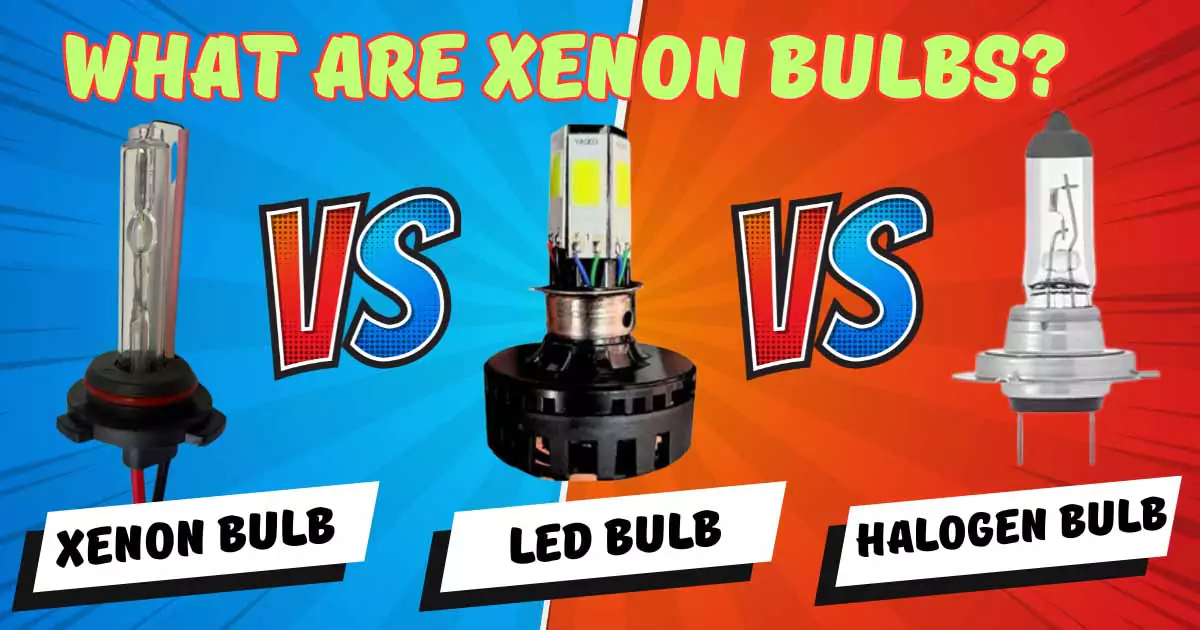Lighting plays an important role in our daily lives, whether it is lighting our homes, workplaces, or vehicles. Over the years, different types of light bulbs have been developed to meet diverse needs, with xenon, LED, and halogen bulbs being some of the most commonly used. Understanding the differences between these technologies will help you make an informed decision based on your specific requirements.
Let’s take a look at the characteristics of xenon bulbs. Then compare them with LED and halogen lamps to find out which is best for you.
Finally, the article also guides you in choosing a lighting source that meets your needs.
What are Xenon Light Bulbs?
Xenon light bulbs are also known as High-Intensity Discharge (HID) bulbs. They use xenon gas to produce bright and intense light. These bulbs operate by passing an electric current through a chamber filled with gas, which excites the gas and produces a bright white or bluish light. Unlike traditional incandescent bulbs, xenon bulbs do not rely on a filament. It gives a better service life than normal incandescent bulbs.
Key Features of Xenon Light Bulbs:
• Luminous Intensity:
Xenon bulbs have a high luminous intensity, which can effectively illuminate large areas. This is why they are particularly popular in car headlights, where clarity and brightness are key factors for safe driving.
• Color Temperature:
Xenon bulbs have a color temperature between 4,000K and 6,000K, meaning they produce light that is similar to natural daylight. This improves visibility and reduces eye strain.
• Energy Efficiency:
Xenon bulbs consume less energy than halogen lamps but are not as efficient as LEDs. They provide a good middle ground for general household use.
• Longevity:
Xenon bulbs have an average lifespan of around 2,000 to 5,000 hours, much longer than their shorter-lived halogen counterparts, but still not nearly as long as LED bulbs.
• Applications:
Xenon bulbs are used in automotive headlights in particular. They are also used in searchlights and projectors, as well as in some medical devices, as their brightness is virtually unsurpassed and they provide a crystal-clear image.

Xenon vs LED vs Halogen bulbs: A Detailed Comparison
1. Brightness and Light Quality
- Xenon: Xenon bulbs are super bright and produce a natural light that is similar to daylight, which makes them perfect for outdoor or automotive applications.
- LED: LED (light emitting diode) lamps with brightness levels equivalent to those of xenon bulbs. LED also offers the color temperature of light, from a warm white to cool daylight.
- Halogen: Halogen bulbs are the dimmest, giving out a soft and yellow light that is low in brightness compared to the other options on offer.
2. Energy Efficiency
- Xenon: Xenon lamps save electricity compared to Halogen.
- LED: LEDs are the most energy-efficient option as they consume up to 80 % less energy than traditional incandescent bulbs.
- Halogen: Halogen bulbs are the least energy-efficient compared to Xenon and LED lamps. They convert a large proportion of the energy into heat instead of light.
3. Lifespan
- Xenon: Xenon lamps last between 2000 and 5000 hours, depending on how they are used. The better the quality, the longer the service life.
- LED: LED lighting can remain switched on for 25,000 to 50,000 hours without interruption, making it the most durable choice.
- Halogen: Halogen lamps have the shortest service life and generally burn out after only 1000-2000 operating hours.
4. Cost
- Xenon: Although xenon lamps are expensive, they also require the replacement of other components such as ballasts. Therefore, certain additional costs are usually incurred.
- Led: LED light bulbs may be more expensive initially, but their efficiency and long service life save money in the long run.
- Halogen: Although halogen bulbs appear to be the cheapest to buy, they can be more expensive in the long term due to frequent replacement and repair costs.
5. Environmental Impact
- Xenon: More gas Disposable, less environmentally friendly than LED. In addition, xenon lamps consume more electricity than LED bulbs.
- Led: LED bulbs are the most environmentally friendly. They consume little electricity, have a long service life, and contain no hazardous substances.
- Halogen: Halogen bulbs have a relatively high environmental impact due to their shortened service life and energy wastage.
6. Applications
- Xenon: Ideal for automotive headlights, outdoor lighting, and special applications requiring very bright light.
- Led: Suitable for almost any application, including residential, commercial, automotive and decorative lighting.
- Halogen: For interiors, accent lighting and applications requiring a soft, warm light.
The Pros and Cons of Each Lighting Technology
Pros | Cons | |
Xenon Bulbs | Bright and visible | Higher energy consumption than LED |
Larger life than halogen bulbs | Need a ballast for operation | |
Ideal for automotive and outdoor applications | Moderate environmental impact | |
LED Bulbs | High efficiency of energy use and a long life span | Buy with high costs |
Wide range color temperatures and applications | Require a suitable heat sink | |
Eco-friendly | Require driver circuit | |
Halogen Bulbs | Cheap and convenient to replace | Brief life span, high energy consumption |
Produce warm, welcoming light | Produces substantial heat | |
Not suitable for bright applications |
Choosing the Right Light Bulb for Your Needs
The choice between xenon, LED, and halogen lamps depends on your specific requirements, preferences, and budget. Here are some suggestions for common applications:
1. Automotive Lighting
- Best choice: Xenon or LED.
- Xenon and LED lamps are brighter and more visible when driving at night, while LEDs are more energy-efficient and have a longer service life.
2. Residential Lighting
- Best Choice:
- LEDs are ideal for lighting residential buildings because they are energy-efficient, versatile, and allow a wide range of color temperatures.
3. Outdoor and Commercial Lighting
- Best Choice: LED or Xenon.
- LEDs are superb for outdoor and commercial applications due to their robustness. For applications that require very high brightness, however, there is hardly any alternative to xenon lamps.
4. Decorative or Accent Lighting
- Best Choice: LED or Halogen.
- Halogen bulbs provide a warm glow. LED bulbs offer various options for dimming and light color customization.
Conclusions
Each of the three lamp types (Xenon, LED and halogen) has special properties that make it particularly suitable for certain applications. Despite the predominance of xenon lamps for vehicle lighting brightness, LED lamps are a smart new solution used in many places today. The energy efficiency, versatility, and longevity of LEDs are bringing them to the fore. The lower-tech halogen alternative is still a good choice for specific applications thanks to its low cost.
So if you know the advantages and weaknesses of each product, you can choose the right product for your specific situation. Whether you want to improve brightness, save money or avoid darkness – whatever your main priority, there will be a lighting staircase perfect for your situation.

